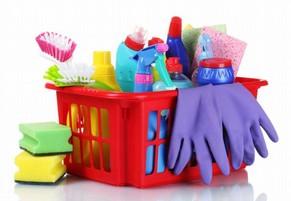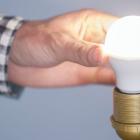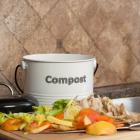The carbon footprint of household cleaners
Submitted by Trista Dorscher on | Updated Wed, 25/10/2017 - 16:28

Knowledge and awareness are key aspects in reducing your carbon footprint. By understanding the contents of the products you are using, it becomes much easier to make carbon-friendly choices in your own home. Because of this, practicing DIY-style green cleaning with simple ingredients that you can pick and choose from yourself can significantly reduce your carbon footprint. It can also be fun, crafty and eco-friendly!
Estimated carbon footprints of chemical production vary widely from chemical to chemical. While some estimates place household cleaning and personal care products at approximately 0.7lbs of CO2 emissions per pound of product, this number is nothing more than a widely estimated guess. It is made even harder to predict the carbon footprint of our cleaners due to the lack of information on the actual contents. A study conducted in 2012 by the EWG Cleaners Database concluded that only 7% of cleaning products sufficiently disclose their composition. This means that despite efforts to read labels and search for non-toxic, low impact cleaning products, we may not be aware of what we are using. Even some “Green Cleaning” brands are not transparent with their labels! The only way to be completely confident about the contents of the cleaning products you use is to make them yourself.
Natural ingredients can be just as effective as chemical cleaners as long as you know what to look for in a homemade recipe. You may even have most of the main ingredients in your kitchen already! My personal favorites to keep on hand are white vinegar (I literally use this in almost every cleaning recipe), baking soda, lemons, borax and castile soap. All of these ingredients can be bought in bulk with minimal packaging and have known cleaning properties that make them safe, effective and carbon-friendly alternatives.
A little more about homemade cleaning powers…
White vinegar is great for cutting grease, deodorizing and disinfecting. It is a main ingredient in homemade countertop and glass cleaners and can even be used on its own to replace fabric softener! This does not leave your clothes smelling like vinegar, but it does leave them fresh and soft.
Baking soda is commonly used to deodorize, cut grease, whiten, and lift dirt stains. Not only can it be used on its own to keep your fridge from getting smelly, but you can also sprinkle a bit in your shoes or gym bag to whisk away unwanted smells. Due to its diverse uses, baking soda is also an ingredient in laundry detergent, bathroom tile and porcelain cleaners, all-purpose counter cleaners, and toothpaste!
Lemons make ideal disinfectants due to their acidity. They also have strong whitening properties, and a squeeze of lemon juice can even be mixed with baking soda to derive an all-natural clothing stain remover and teeth whitener all in one!
Borax and castile soap are mainly used for laundry detergent. Castile soap lifts dirt and cuts grease, while borax disinfects, whitens and fights mold and mildew. Because of this, borax is also a main ingredient in bathroom cleaners. Coarse salt also has mold-fighting power, and is right in your own pantry.
Storage and Packing
You will also need containers for storing your cleaning creations! I recommend purchasing only what you need, putting those mix-matched Tupperware containers to use, and looking for spray bottles that are sturdy enough to be re-used multiple times. One spray bottle can serve many purposes by being continuously re-used and this will minimize your plastic packaging waste.
Packaging accounts for 35% of plastics produced. Depending on the type of plastic, the carbon footprint can be between 2 to 4 pounds of carbon per pound of packaging. When you buy your cleaning products in bulk and re-use your spray bottles and containers, you can reduce your amount of plastic packaging, thereby reducing your carbon footprint by an average of 3lbs pounds of CO2 per cleaning product!
It is also worth noting that most homemade recipes have long shelf lives in the order of months. None of the ingredients used expire so there’s no fear in making large batches to save on time.
Try some of these simple recipes for all of your cleaning needs:
Laundry Room
Using an average, store-bought detergent will give an approximate carbon footprint of 1-2lbs CO2 per load. There are simple tricks to laundry that will instantly help reduce this footprint. For example, store-bought powder detergents have a higher carbon footprint than liquid detergents. The higher concentrated liquid detergents have the lowest carbon footprint, since they require less packaging and smaller quantities of detergent per load of laundry.
Recipes for do-it-yourself laundry detergent are simpler than you would think! By making your own detergent, you can reduce your carbon footprint by up to 0.5lbs CO2 per wash! As mentioned earlier, you can also replace liquid laundry softener with approximately 1/3 cup of white vinegar, which would further reduce the carbon footprint of packaging and transporting even more products.
Laundry Detergent Recipe:
-
1 L hot water
-
1 cup baking soda
-
1 cup liquid castile soap
-
1/3 cup coarse salt
Dissolve dry ingredients first, and then stir in the soap. You can also add essential oils for scents and disinfecting properties (depending on the oil) if desired. This detergent is effective for cold-water washes – further reducing your carbon footprint!
Bathroom
Toilet bowl cleaner
-
¼ cup baking soda
-
1 cup white vinegar
Put ingredients directly into toilet and let sit for 15 minutes and scrub. Done!
Tub and tile cleaner
-
1 2/3 cup baking soda
-
½ cup castile soap
-
½ water
-
2tbs white vinegar
Combine in a container and shake well. Apply using a cloth or sponge. Note: vinegar and baking soda will get fizzy, use a larger than necessary container.
Kitchen and Countertops
Glass Cleaner
-
¼ cups vinegar
-
4 cups warm water
Combine in a spray bottle and use. Another simple and effective use for vinegar!
All-Purpose:
-
½ cup vinegar
-
1 cup water
-
¼ lemon (juice)
Combine in a spray bottle and use with a dry or slightly moist cloth. I sometimes leave lemon wedges and basil leaves in the spray bottle, partly to hide the vinegar smell and partly because it looks pretty!
Hopefully these cleaning tricks give you an idea of some alternatives to chemical cleaners, helping to achieve a healthier, more carbon-friendly home! The Internet is full of handy recipes, but be sure to do your research on the individual ingredients and why they work before you use them or, when in doubt, just stick to the basics listed above.
Sources:
Amounts of CO2 Released when Making & Using Products http://www.co2list.org/files/carbon.htm
Apartment Therapy: How to Make Your Own Bathroom Cleaners http://www.apartmenttherapy.com/how-to-make-your-own-bathroom-cleaners-shopping-list-recipes-108150
David Suzuki Foundation, Queen of Green. Green Cleaning Recipes http://www.davidsuzuki.org/publications/downloads/2011/QueenOfGreen-Green-cleaning-recipes.pdf
Environmental Working Group (EWG) www.ewg.org
EWG Data Base (2012) http://static.ewg.org/reports/2012/cleaners_hallofshame/cleaners_hallofshame.pdf
How Laundry Detergent Works http://home.howstuffworks.com/laundry-detergent4.htm
Waste Online: Plastics Recycling https://dl.dropboxusercontent.com/u/21130258/resources/InformationSheets/Plastics.htm
You will save the Earth by sharing and/or tweeting (corny right?)





